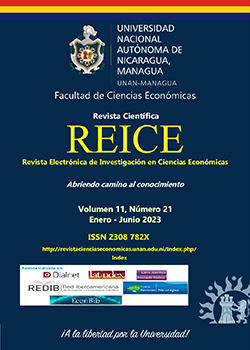Assessment of digital maturity, the transformation of business models in the context of digital transformation
DOI:
https://doi.org/10.5377/reice.v11i21.16546Keywords:
digitalization, digital business transformation, business processes, digital maturity, digital maturity model, maturity levelsAbstract
In the context of digital transformation and the dynamic integration of technologies, organizations' business models undergo optimization and improvement. This process necessitates the evaluation of an organization's digital maturity to gauge the extent of its digital business transformation, as well as the stage and level of technology implementation within the company. The objective of this article is to construct a digital maturity model that facilitates the assessment of the implementation status of Industry 4.0 technologies in the international logistics sector. This assessment will be conducted through a quantitative evaluation of the incorporation of diverse elements of Industry 4.0 into logistics operations. Methodology. The present study has devised a pragmatic model for assessing the digital maturity of the logistics sector, relying on two primary criteria: 1) the stages (degrees, levels) of maturity (i.e., Ignoring, Defining, Adopting, Managing, Integrated) as proposed by Facchini et al. (2020); and 2) the various types of technologies implemented within the logistics sector. Results. An estimation of the digital maturity model within the logistics sector has been conducted to delineate the level of implementation of diverse Industry 4.0 technologies. The results of the maturity model illustrate that the international logistics sector is currently in the early stages of integrating Industry 4.0 technologies, with limited utilization of digital solutions, barring notable exceptions such as big data analytics. Among the components comprising the maturity model, big data analytics emerges as the most extensively integrated element, facilitating the collection, processing, and evaluation of data by companies. The transition from the initial to the subsequent stage of digital business maturity is demonstrated by the incorporation of Enterprise Resource Planning (ERP), Networking Management Solutions, and Big data technologies, specifically concerning the digitization of the company's product portfolio, marking the second stage of digital maturity. The practical significance of this research lies in the assessment of the digital maturity model within the international logistics sector, which delineates the state of implementation of various Industry 4.0 technologies.
Downloads
References
Abdirad, M., & Krishnan, K. (2020). Industry 4.0 in Logistics and Supply Chain Management: A Systematic Literature Review. Engineering Management Journal, 1–15.
Banyani, M. A., & Then, D. S. S. (2010). Development of the industry maturity framework facilities management. Proceedings of the 5th Built Environment Conference.
Barreto, L., Amaral, A., & Pereira, T. (2017). Industry 4.0 implications in logistics: an overview. Elsevier. 13. P. 1245–1252. Available from: https://www.researchgate.net/publication/320343294_Industry_40_implications_in_logistics_an_overview.
Batz, A., Oleśków‐Szłapka, J., Stachowiak, A., Pawłowski, G., & Maruszewska, K. (2020). Identification of Logistics 4.0 Maturity Levels in Polish Companies – Framework of the Model and Preliminary Research. Sustainable Logistics and Production in Industry 4.0, Springer: Cham, Switzerland. 161–175.
Facchini, F. et al. (2020). A Maturity Model for Logistics 4.0: An Empirical Analysis and a Roadmap for Future Research. Sustainability. 12. 86. DOI: 10.3390/su12010086.
Fatorachian, H., & Kazemi, H. (2020). Impact of Industry 4.0 on supply chain performance, Production Planning & Control, 1–19, DOI: 10.1080/09537287.2020.1712487.
Felch, V., Asdecker, B., & Sucky, E. (2019). Maturity models in the age of Industry 4.0–Do the available models correspond to the needs of business practice? Available from: https://aisel.aisnet.org/hicss-52/in/digital_supply_chain/3/.
Gökalp, E., Şener, U., & Eren, P. E. (2017, October). Development of an assessment model for Industry 4.0: industry 4.0-MM. In International Conference on Software Process Improvement and Capability Determination (pp. 128–142). Springer, Cham.
Hahn, G. J. (2020). Industry 4.0: a supply chain innovation perspective. International Journal of Production Research. 58 (5), 1425–1441. DOI: 10.1080/00207543.2019.1641642.
Hofmann, E., & Rüsch, M. (2017). Industry 4.0 and the current status as well as prospects on logistics. Computers in Industry, 89, 23–34. DOI: 10.1016/j.compind.2017.04.002.
Klimko, G. (2001). Knowledge management and maturity models: Building common understanding. In Proceedings of the Second European Conference on Knowledge Management, Bled, Slovenia, 8–9 November 2001, 269–278.
Maier, A. M., Moultrie, J., & Clarkson, P. J. (2012). Assessing organizational capabilities: Reviewing and guiding the development of maturity grids. IEEE Trans. Eng. Manag, 59, 138–159.
MarketWatch (2020). Blockchain in Logistics Market 2020. Available from: https://www.marketwatch.com/press-release/blockchain-in-logistics-market-2020-emerging-technologies-sales-revenue-size-share-growth-key-players-analysis-development-status-opportunity-assessment-and-industry-expansion-strategies-forecast-to-2025-2020-09-25.
MarketWatch (2020). Global Cyber-Physical System Market Size in 2020. Available from: https://www.marketwatch.com/press-release/global-cyber-physical-system-market-size-in-2020-industry-demand-market-share-trend-industry-news-business-growth-top-key-players-top-countries-analysis-and-outlookshowing-impressive-growth-by-2026-2020-09-10.
Nagy, J. et al. (2018). The Role and Impact of Industry 4.0 and the Internet of Things on the Business Strategy of the Value Chain – The Case of Hungary. Sustainability. 10. 3491. DOI:10.3390/su10103491.
Okongwu, U., Morimoto, R., & Lauras, M. (2013). The maturity of supply chain sustainability disclosure from a continuous improvement perspective. Int. J. Product. Perform. Manag., 62, 827–855.
Pigosso, D. C. A., Rozenfeld, H., & McAloone, T. C. (2013). Eco-design. J. Clean. Prod. 59, 160–173.
ReportLinker (2020). The Global Blockchain Technology Market in Transportation and Logistics Industry Market is expected to grow by $ 811.51 million during 2020–2024 progressing at a CAGR of 54% during the forecast period. Available from: https://www.globenewswire.com/news-release/2020/09/08/2090083/0/en/The-Global-Blockchain-Technology-Market-in-Transportation-and-Logistics-Industry-Market-is-expected-to-grow-by-811-51-million-during-2020-2024-progressing-at-a-CAGR-of-54-during-th.html.
Research and Markets (2020). Global Logistics & Supply Chain Industry Market - Post COVID-19 the Market is Projected to Grow from USD 2,734 Billion in 2020 to USD 3,215 Billion by 2021. Available from: https://www.globenewswire.com/news-release/2020/05/11/2031082/0/en/Global-Logistics-Supply-Chain-Industry-Market-Post-COVID-19-the-Market-is-Projected-to-Grow-from-USD-2-734-Billion-in-2020-to-USD-3-215-Billion-by-2021.html.
Rogers, E. M. (1983) Diffusion of innovations. N. Y., Free Press.
Simpson, J. A., Weiner, E. S. C. (1989). The Oxford English Dictionary. Oxford University Press, Oxford.
Sternad, M., Lerher, T., & Gajšek, B. (2018). Maturity levels for logistics 4.0 are based on NRW's Industry 4.0 maturity model. Business Logistics in Modern Management.
Wendler, R. (2012), The maturity of maturity model research: A systematic mapping study, Information and Software Technology, 54 (12), 1317–1339.
Westermann, T., Anacker, H., Dumitrescu, R., & Czaja, A. (2016). Reference Architecture and Maturity Levels for Cyber-Physical Systems in the Mechanical Engineering Industry, 2016 IEEE International Symposium on Systems Engineering, 1–6.
Downloads
Published
How to Cite
Issue
Section
License
Copyright (c) 2023 Revista Electrónica de Investigación en Ciencias Económicas

This work is licensed under a Creative Commons Attribution-NonCommercial-ShareAlike 4.0 International License.



